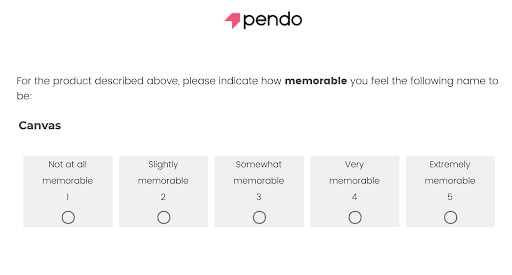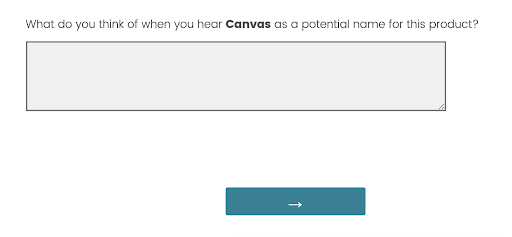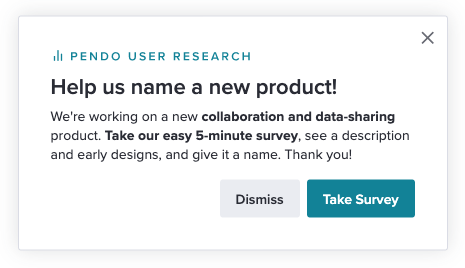There’s a lot of meaning in a name. Names can evoke emotion, conjure up images, and have positive or negative associations. And for new products or features, naming is often the hardest thing to do. As a product marketer, I am often stumped by the task of selecting the best name—one that captures both the ethos and value of the product, all without sounding too esoteric.
Recently at Pendo, we embarked on a new process to help guide how we name our products: we asked our very own customers. In the spirit of showing the data (one of our core values) we collected and analyzed feedback from those who love our products—and ended up with some pretty interesting results.
Here are some learnings I took away from this product naming process:
First, start with naming principles
Before we even began conducting customer research, we found it useful to take a step back and come up with naming principles to help narrow the scope of potential names on our list. Working with a multidisciplinary team including product, product marketing, product operations, and design, we keyed in on a set of five principles that aligned with our brand voice and intent for practicality. Why five? Though a bit arbitrary, five covered enough ground without being too restrictive. Too many principles, and it’ll become hard to remember what’s actually important.
To help inspire you, our own five principles included:
-
- Keep names simple, literal, and clear.
- Strive for consistency and usability at all times (across the web, the product, sales assets, digital media, and others).
- Communicate benefits.
- Select names that are lasting.
- Evoke a direct but friendly tone.
Brainstorm and build a list of name options
With that same multidisciplinary team, we then pulled together a long list of potential names for the new product. Remember: Anything goes in a brainstorm, and we recommend holding a jam session with any and all relevant stakeholders. To help get the creative juices flowing and provide some guardrails, here are two considerations to keep in mind:
-
- Reiterate the value proposition of the new product or feature. In our case, the new product had themes of collaboration and data democratization. Simply raising those value props helped inspire some imagery and interesting names.
- Keep the end-user persona for the new product or feature in mind. For us, the primary persona was a product manager or leader, and secondarily, anyone who touched the product, such as product design or research. This helped us avoid names that were either too similar to adjacent products or could be confused with commonly known definitions (e.g., Groups).
With a long list of potential names in hand, the next step is to trim the fat and create a shortlist of potential winners—ideally no more than ten. Remember the naming principles in step one? Here’s where those principles come in handy.
Grade each name using the naming principles as the criteria. I find using a 1-5 grading scale usually suffices for this exercise. Eliminate names that fall short of satisfying the criteria, keep those that score high, and make a call on those that fall somewhere in the middle. Ruthlessly eliminate until you are left with a curated list of great names.
Finally, look to your customers for help
Staying true to our value of being focused on the customer, no decision is ever complete without customer feedback as an input. So, we wanted to gather thoughts, comments, and ideas from our very own users. While there are many research methods to gather customer feedback, we decided to use a in-app survey to optimize for more responses.
Admittedly, the process to get to our shortlist of five names was rigorous and at times lengthy. But it was essential for designing the survey and getting feedback from customers quickly and in a targeted way. Our primary goal was to gain insight into how each of these five names would resonate with our customers. To that end, we designed the survey to include questions specifically about each of the five names.
Step 1: Creating the survey
We included a set of questions that asked for a five-point rating for each name across a set of attributes. These attributes were directly tied to the naming principles discussed earlier and included clarity and memorability, among others. In other words, respondents would select how memorable a name felt on a five-point scale.
For each name we also asked: “What do you think of when you hear Name A as a potential name for the new product?” Here, we found particularly interesting responses that called out both negative and positive associations, and even some cultural references that only Americans would understand.
We also threw in an open question and asked: “What would you name the product described above?” Here, we wanted to crowdsource new and interesting ideas and we were both impressed and surprised by the variety of responses. The word cloud below shows the most common names submitted in the survey responses. I think my favorite was “Pendollab”—a portmanteau word that combines Pendo and collaboration.
Pro tip: Include context upfront on the new product or feature. Adding a short description of what the product does, the value it provides, and a few visual mockups will help your survey respondents provide more informed answers.
Step 2: Deploying the survey
To actually deploy the survey, we built an in-app guide targeted to our customer panel, a segment of customers our team draws on for this type of research. When they clicked “Take Survey,” they were directed to a Qualtrics survey. Paired together, we were able to reach our own customers quickly and use Qualtrics’ advanced survey capabilities to ask complex questions. Within a week’s time, we collected nearly 100 responses.
By soliciting input from our very own customers, we were able to identify a clear winner from our list of five options. Having that initial vote of confidence from our customers is like a mini go-to-market test; it assures that our chosen name won’t completely flop upon launch. While naming products can feel vague, put a little structure behind it and a dash of customer feedback, and you’ll be surprised by the results you get.
Oh, and what name did we decide on you ask? You’ll hear more about the new product soon.




![[object Object]](https://cdn.builder.io/api/v1/image/assets%2F6a96e08774184353b3aa88032e406411%2F16b6f2565d1d4a5585db322386f9be7f?format=webp)
![[object Object]](https://cdn.builder.io/api/v1/image/assets%2F6a96e08774184353b3aa88032e406411%2F728d67faa5f64299b8f8f0b138881fb5?format=webp)
![[object Object]](https://cdn.builder.io/api/v1/image/assets%2F6a96e08774184353b3aa88032e406411%2Fc08c4160a2724c4fa3d365eb43791b09?format=webp)

